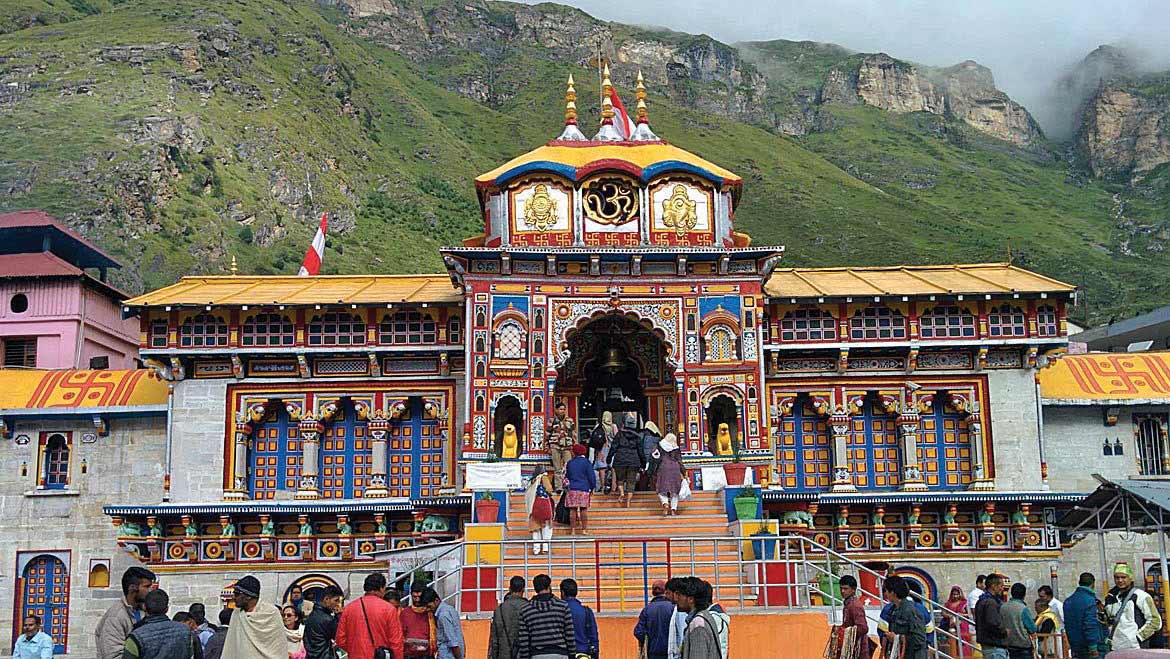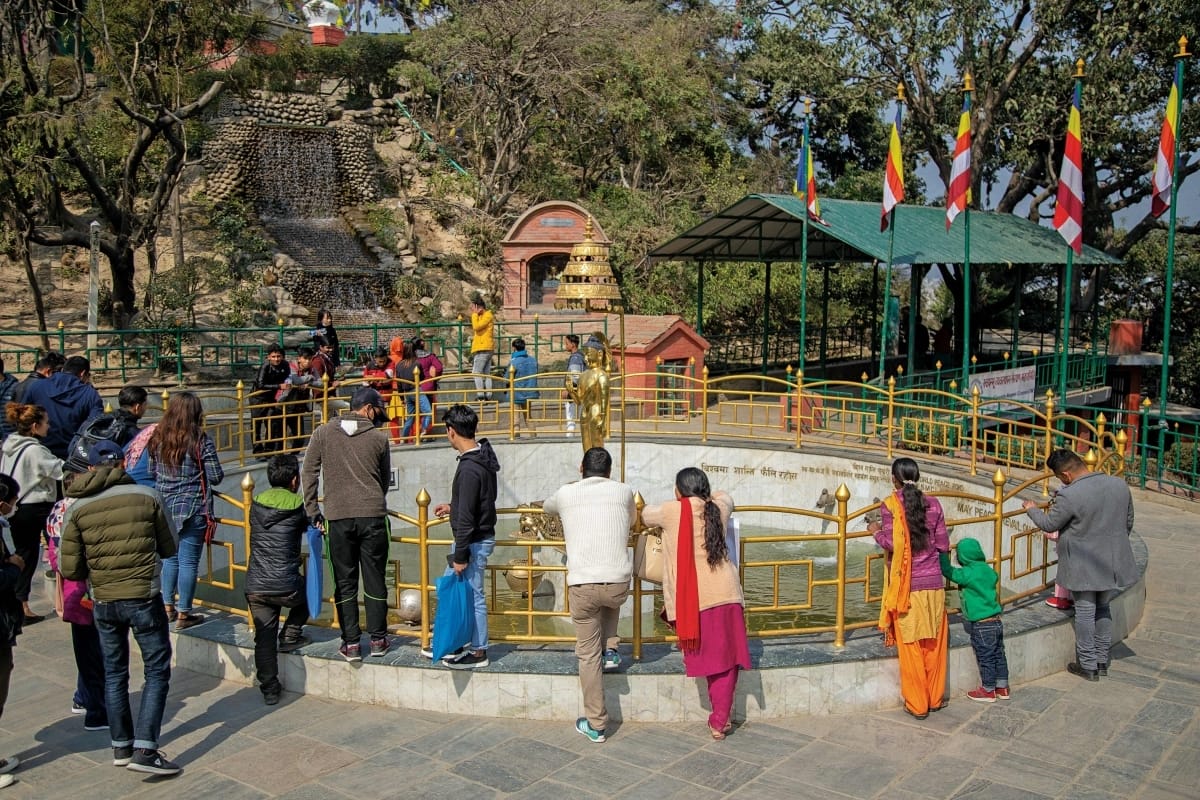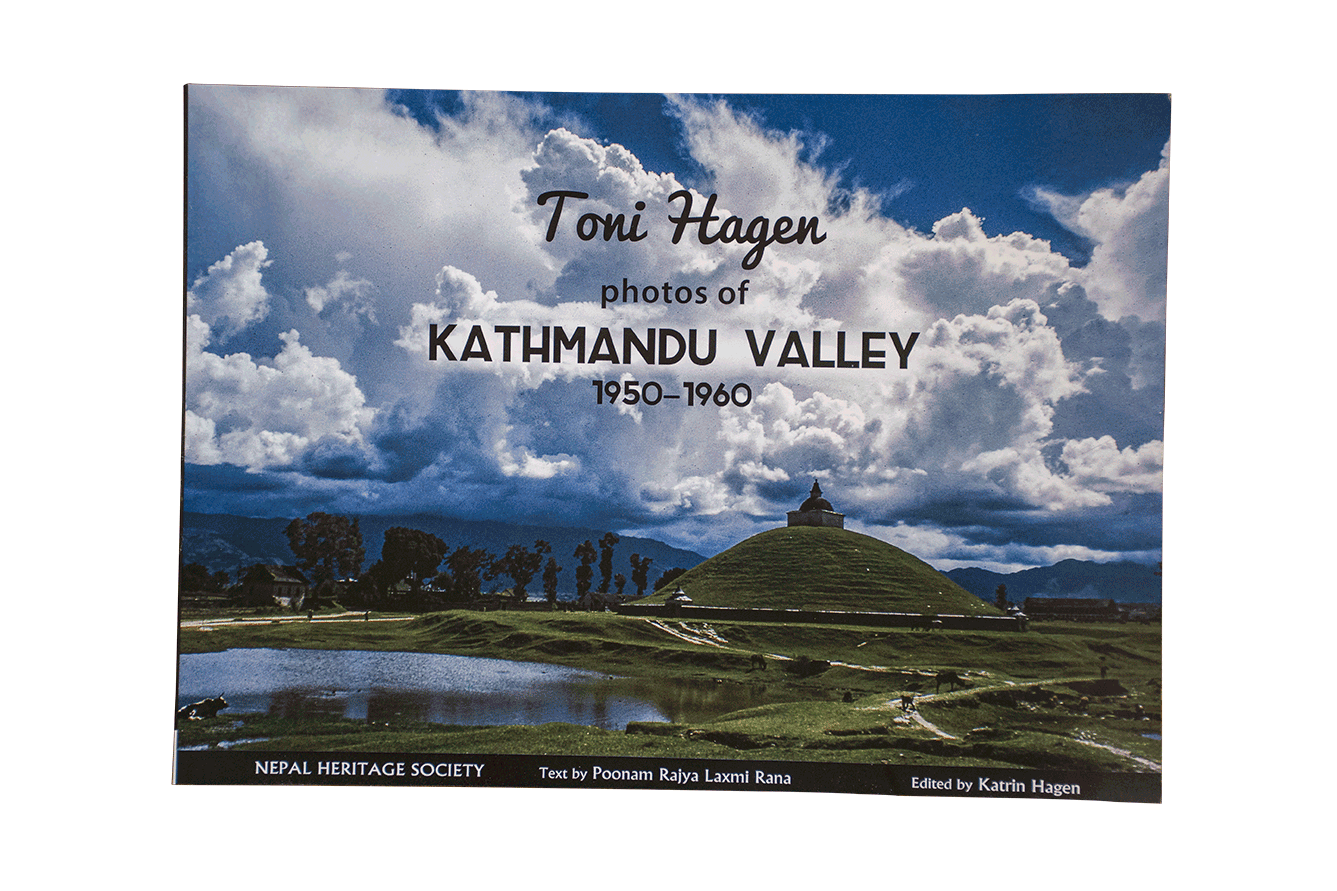Set in the gentle folds of the midland mountains in the shadow of formidable Annapurna peaks, high above the Modi river valley in a rolling hilly countryside, this undemanding trek provides amazing glimpses of rural life.
Ghandruk, the famous Gurung village at 2,010m (6,600ft), is located northwest of the lakeside city of Pokhara. It is accessible in one day, with a four to five hour walk after a short ride from the city. Given that the small village is on the much used trail to the Annapurna Sanctuary or the Annapurna Base Camp (also called ‘ABC’ by trekkers), it claims to be the most visited trekking area in Nepal, and is widely known and popular among international visitors. After opening the Pokhara-Baglung highway in the mid 1990s, Ghandruk (Ghandrung on some maps) has seen a gradual increase in domestic tourists as well.
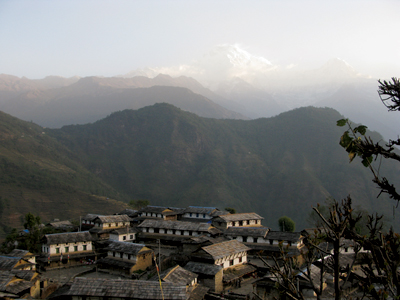 Popular Route
Popular Route
With easy access by road, followed by a short hike of just five hours, and with only a mild physical challenge, Ghandruk as a travel destination is a comfortable bargain. The first leg of the journey begins in Pokhara from where you can drive your own vehicle or hire one or, catch a bus, for the initial 55km trip along the Pokhara-Baglung highway. The road goes up and down with many switchbacks past notable towns like Hyangja, Phedi, Naudanda and through a foggy pine forested highland called Lumle, then down a curvy road to Nayapul, where the hike begins. A steep slope leads to a suspension bridge (the actual naya pul, or ‘new bridge’, when it was built years ago) over the Modi Khola (river). For a half hour, you walk along the Modi Khola to the brisk bazaar of Birethanti.
If your destination is confined to Ghandruk, the trail is popular enough and easy enough, well used by trekkers and locals alike, that you can do without a guide. Foreigners, however, are advised to consult their travel or trekking agent either in Kathmandu or Pokhara regarding trekking permits, and guide or porters, if needed. As you walk along to the fringe of Birethanti, note that the path divides into two—one goes west up the tributary Bhurungdi river to Tikhedunga and then on an old and well forested trail to Ghorepani (or Ghodepani) pass, an old horse watering place (a ghode pani), while the trail you want goes right, from Birethanti on up Modi river valley to Ghandruk. The well-stocked shops of Birethanti may tempt you to buy something essential for your hike. But note that the busy Ghandruk trail itself has numerous teahouses and eateries that, besides serving tea, soft drinks, and dal-bhat (rice and lentils), also stock sundry items from superglue to batteries, Toblerone chocolates, Mars bars and Snickers, energy drinks, beer, and other ‘what have you’.
Amusing Company
As you walk past Birethanti you will get your first glimpse (and pungent smell) of mules, some tethered by the side, others being herded by the muleteers, some laden, others not, plodding along the path, sometimes coming at a canter your way, the distinct peal of the bells round their necks announcing their arrival. Curiously, all the mules are festooned with colorful ribbons, trinkets and funny headgear that’ll make you chuckle. Naturally, you will click a few snaps. The only means of bulk transport in these hills and mountains, these beasts of burden are used to lug up all manner of goods: bags of cement, cylinders of gas, loads of rice, perhaps a TV set, and the like, to treacherous heights in hostile climatic conditions. These are loads that porters cannot dare imagine.
As you proceed farther, you are in for more surprises as you encounter groups of foreign tourists, small and large, young and old, some carrying heavy packs, others with only light rucksacks; some escorted by guides and, close at their heels, porters carrying camping gear on their backs in traditional dokos (wicker baskets). As Birethanti recedes behind you, the trail crosses a small side stream by a suspension bridge and then becomes a wide path, almost a road, following the river to a stopgap bridge. Construction of a vehicular bridge was in progress when I was last there (July 2009). The tumbling Modi appeared light brown with a whitish glacial tint. Snow melt high up in the Annapurna range combined with the monsoon rains had caused the water to turn murky. For my family and me, the river, a raging torrent, was quite a site as it thundered past over huge boulders, with rocks strewn all along the watercourse in a great mass. “After the monsoon,” an elderly fellow whom we met at the riverside informed us, “the water is gin clear and teems with asla and jalkapur.” Asla (snow trout) and jalkapur (a small fish from the catfish family) are considered delicacies in the riverside villages.
Old Trail
As you follow the wide path, the river Modi still close to your right roars past going south around the contour of the hill. Where the wider path (a new seven kilometer fair weather road) heads straight up, you’ll see a small placard that reads ‘Old Trail’ pointing a little to the right, to a narrow trail that runs along the riverbank. It’s nothing to get confused about, even if you are a first timer (we were). Both routes converge way up at Syauli Bazaar. If you wish to confirm, the locals around will readily help you out. Naturally, you’ll want to walk the old trail (we did).
To your left, the hills continue upwards until both the routes meet on the horizon. After something like an hour, you leave Lamakhhet (literally ‘Lama’s Field’), pass a birch forest and arrive at Syauli Bazaar, a small settlement of Gurungs and Magars. There you’ll find a number of shanty houses, tea stalls, and inns. After Syauli Bazaar, the trail runs along the contour of the mountain to the left. The Modi valley, below, keeps you company on the right. All along, the trail winds through terraced fields that flank you on either side; they then gently drop in perfect symmetry to the banks of the Modi at the foot of the hill. From here on, the trail is paved with uneven stones and becomes steeper. The ever-changing and magnificent mountain landscape is beautifully distracting. A word of caution here, as you haul yourself up the uneven and jagged stone stairs that keep you company from here: keep a wary eye on those stone steps and on the copious mule droppings. You can twist an ankle on the one and slip or dirty up your trekking shoes on the other.
Busy Trail
As you continue upward, the ridges on either side of the trail rear up high above the narrow valley, the erstwhile loud rumble of the river growing fainter below you. While the hills across the river appear densely forested, the hills on the trailside look denuded, and rockier, with outgrowths of wild grass. The trail is fairly busy and it is little surprise if you keep meeting trekkers and villagers, most of whom greet you with the ubiquitous “Namaste”. A mix of all nationalities—American, Italian, British, Japanese and others. If you stop to exchange a few words you will learn that some are back from Ghorepani and Pun Hill (the popular Himalayan viewpoint above Ghorepani), while others have done a daunting ascent to the ABC, further up the Modi valley. You’ll also encounter frequent mule trains, the scariest when an entire pack is hurtling down the stone steps at you, or when you get caught on a bend or a narrow place with no room to jump aside. Take my word, it is best to give them wide berth from the moment you hear their bells coming and, if you have a choice, step uphill away from them, not downhill. More than one trekker has been knocked off the downside of a trail by a mule’s bulky load.
Leaving behind the handful of houses and tea shops at Kliu, and a suspension bridge on a small stream called Sadhu Khola, the hike continues upwards to Kuine Danda (literally ‘corner hill’ or ‘bend of the hill’). Look across to your right high above the Modi river valley and you can make out tin forms bunched together in the distance. That is Landruk (or Landrung), another popular Gurung village that is on an alternate trail. Meanwhile, with your gain in altitude, the hillside at your left changes to pine and rhododendron that stretch all along to the top of the line of hills. The stone steps continue zig-zagging upwards past terraced fields and a handful of houses at intervals. As you stop to catch your breath and crane your neck upwards, you can make out a distant cluster of houses on a steep incline. That’s Kimchi.
The village of Kimchi has a number of inns and eateries with European and Chinese dishes on the menu, besides dal-bhat. The restaurant where we ate our meal had a tin-roofed open patio that looked over the Modi river valley with a view of the long winding trail we had come up. Seated next to us, a Taiwanese group just back from Pun Hill was talking animatedly. You’ll notice that most of the tea houses on this trail display a legend board with the hand-drawn diagram of the Annapurna circuit and an arrow pointing to the respective place that reads: ‘You are Here’. You may want a little refreshment at Kimchi, or a whole dal-bhat meal (if you arrive at lunch time, as we did), since the trail lacks decent food outlets for the rest of the way to Ghandruk.
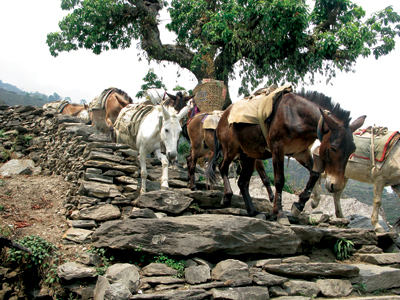
The Gurungs like to pave their trails with big stones but it appears to be tough going for donkeys!
Rolling Countryside
As you carry on up the steep path, you’ll have a closer view of Machhapuchhre, or ‘Fish Tail’ peak at the north, if weather permits. The day we were there, heavy monsoon clouds and haze allowed us only the tip. As the name suggests, the snow-capped peak rearing its two pronged crest truly bears resemblance to a fish’s tail. As you approach a small settlement called Chane, the steepness eases up. Save for a handful of tea houses, Chane otherwise dons an isolated look. After a short while, the trail leads through a jumble of rocks and boulders, the aftermath of a huge landslide that came down in 1995, according to a local villager I spoke with. About a half hour later as you crest a ridge, you will find the path well paved with stones and stairs at irregular intervals. Thereafter, the trail follows the contour of the hill past lush green trees.
There are steel railings along the well-paved wide stone path, which led Bryn Thomas, in his book Trekking in the Annapurna Region, to remark that “The path is reminiscent of remaining parts of the Inca Trail that trekkers still follow on the way to Machu Picchu in Peru.” These railings—on the way to Machhapuchhre in Nepal—continue only for a short stretch, however. The last leg of the hike involves yet more stone steps that lead steeply up the hillside. It seems that the Gurungs like to pave their trails with big stones. A wayside sign reads ‘Ghandruk: 2010m’, as you enter the village. The big Gurung community hugs the hillside gradient and sprawls out in a split-level fashion. Check into a lodge or an inn. They are found at almost every corner. Note that while Ghandruk is a predominantly ethnic Gurung village, other residents include the artisan castes and ethnic Magars. The majority is Buddhist, others are Hindu.
The Enchanted land of the Tamus
The Gurungs (who call themselves Tamu in their own language) are an ethnic group whom some believe to have originated in Mongolia. They have been called a ‘martial tribe’ by the British, and are renowned for bravery as Gurkha soldiers in the British, Indian and Nepal armies. A number of Gurung soldiers came home from the First and Second World Wars bearing Victoria Crosses for their bravery. The Gurungs are found all across the south slopes of the Annapurna range. Ghandruk is their second largest village after Siklis, farther east. Previously dependant on cattle raising and hunting in the high forest, and sedentary farming on the terraced hillsides, the Gurungs of Ghandruk are today considered an affluent community that has prospered economically from handsome paychecks and retirement pensions earned from the service as British Gurkhas, and lately from trek tourism. The old trend of joining the British Army is still in practice but in far fewer numbers than in the past. So, lately, the youth have sought other employment overseas in the oil-rich Mideast, and in Southeast and East Asia. And, as a result of burgeoning trekkers’ traffic here in the Annapurna hills, and from the looks of the many lodges, inns, and teahouses, the hospitality business also thrives.
The views from Ghandruk are awesome. At the east, terraces drop dramatically into a deep gorge carved by the glacier-fed Modi River. Above the fields, the densely forested hill soars high. That small cluster of dots on the hillside across the valley is Landruk. One route through these hills is popularly called a “loop trek”, whereby trekkers on return from Ghandruk go down the eastern side of the valley through Landruk, Pothana, Deurali, and Dhampus to Phedi at the very top end of the Pokhara valley. To the west, the hills roll up and over, through a high forest, to the famous trekking spots of Ghorepani and Pun Hill. And, looking south, your eyes drop down into the deep valley where the Modi River winds along towards Birethanti and Nayapul.
The most spectacular view, however, is northward up to the panoply of craggy snow peaks that solemnly gaze down over this Gurung locale. It is almost hypnotic, as your eyes scan left to right and from down to up to the snowy giants—Machhapuchhre at 6,993m (22,943ft) and her sister peaks: Annapurna III, Gangapurna, Hiunchuli and Annapurna South, ranging in height from 6,441m or 21,132ft (Hiunchuli) to 7,555m or 24,787ft (Annapurna-III). No words can do them justice. The enchantment is complete. And all you can take back are those timeless moments preserved in your camera and your mind. Far and away, Machhapuchhre is the most photographed peak from the vantage of Ghandruk village.
With a maze of stone alleyways up and down and criss-crossing each other, the hub of the village is occupied mainly by lodges and inns, and many solidly built houses. For a small village, Ghandruk has over 20 lodges and inns. As you stroll along, taking in rare glimpses of the rural life, you will find the older, more traditional houses higher up. Good humored and friendly, every Gurung man or woman you meet will greet you with a warm smile and a “Namaste”. Almost all houses look identical with brightly colored lime-white tops, ochre-red bottoms and with slate roofs that are supported by carved wooden struts. Most of the houses have verandahs on the ground floors with wooden props in front and mud floors plastered with red clay. Also known to be an orderly community, it is little surprise that every Gurung household looks neat and shipshape and every neighborhood and the stone paved alleys appear freshly scrubbed clean. Poinsettias and marigolds bloom in the foreyards and ears of corn hang drying from the eaves of some homes. Stones are abundant here; pathways are paved with them, and the trailside walls, houses and inns are all built with them.
You may observe some incongruities, however; things starkly out of place, amidst the otherwise traditional village setting. Some lodges are newly built of concrete, a serious departure from tradition. “As a matter of great concern, the local village committee has put a ban on such constructions to retain our traditional identity,” says Hiun Bahadur Gurung, who has been running Sherpa Hotel for the last 12 years. Some like Ker & Downey’s Himalaya Lodge and the Gurung Cottage have held onto the traditional architecture. The Gurung Cottage, a stone and mortar house restored to its old glory, boasts to be almost 200 years old.
A tour of Ghandruk village eventually brings you to a privately run museum that houses a collection of traditional wares from earthenware and kitchenware to clothing, jewelry and iron weaponry and hand-tools, which allow you a rare glimpse into the age-old lifestyle and culture of this ethnic community. If you fancy yourself being photographed in traditional Gurung dress, male or female, they can arrange that too.
At the lower end of the village, a white building houses the Annapurna Conservation Area Project (ACAP) field office. Launched in 1986 as a government undertaking with remarkable local involvement, ACAP promotes resource conservation, community development and eco-tourism management throughout the Annapurna area. The project encompasses a whopping 7,629 square kilometers of mountainous landscape (almost 3,000 square miles) on both sides of the great massif, from as low an elevation as 800m (2,625ft) to the top of Annapurna-I at 8,091 meters.
There are 14 ‘Eight-Thousanders’ in the world, as mountaineers call peaks 8000 meters and above. They are all in the Himalaya/Hindukush. Among them, Annapurna-I is the tenth highest, situated northwest (but out of sight) from Ghandruk. It was the first Eight-Thousander ever climbed, in 1950, by a French team led by Maurice Herzog. Their route was farther west, up out of the Kaligandaki river valley.
Temperate Paradise
Weather-wise, Ghandruk boasts a pleasant climate without extremes of heat or cold, year round. Excluding the monsoon period (July through early Sept), all months are suitable for hikes to Ghandruk, though you might encounter a temporary dusting of snow on some mid-winter days. The village has electricity (generated locally), telephone and a health post. For a comfortable stay, the lodges and inns provide all modern amenities. Some even have Internet access! For a gourmet trekker, they dish out all kinds of great food, from dal-bhat to European and Chinese cuisine. The evenings in the hub area resound to singing and traditional dancing that are arranged by the lodge-owners for their foreign guests. Should you decide to extend your hike, they can arrange trips to Ghorepani and Pun Hill, a day’s walk away, or a more arduous ascent, with necessary logistics, lasting several days into the Annapurna Sanctuary, and to the Machhapuchhre and Annapurna Base Camps.
For a short and undemanding hike, a visit to Ghandruk, set in the gentle folds of the midland mountains, in the shadow of formidable Annapurna peaks, high above the Modi river valley, in a rolling hilly countryside, provides amazing glimpses of rural life. It is (at least) a 300-year-old village in its old form, providing glimpses of time-honored ancient cultural traditions. Here, as guests of the legendary Gurungs, you’ll find a fascinating getaway, both memorable and educational.
Ravi Man Singh is a freelance writer, avid trekker and outdoorsman who lives in Kathmandu. He frequently writes for ECS Nepal magazine, and can be contacted at ravimansingh@hotmail.com
Ghandruk’s Pioneer Hotelier
Motivation comes in different forms; Shankar Bahadur Gurung found his upon his encounter with a group of foreigners visiting Ghandruk. While many villagers during the 1970s were scared to bump into foreigners, Gurung, despite his inadequacy in English, wanted to talk to them and assist them. The foreigners wanted a place to stay, but there was none - no hotel, no lodge. Gurung, hoping to provide them with any type of shelter, offered them lodging at his house. With everybody gathered around the chulo (hearth), and staying together as a family, a day’s stay turned into three. A small house with one door and no windows must have appealed a lot to the guests, for many other foreigners, upon other villagers’ recommendations, began staying in Gurung’s home. The love he received from the tourists motivated him deeply, motivated him to open Ghandruk’s first hotel – Hotel Milan.
Nevertheless, the journey for Gurung wasn’t easy. Financing was the biggest hurdle, but there were so many other factors that Gurung had to deal with. Although basic things like lack of good roads, inadequate supply of materials were obvious difficulties, Gurung also had to deal with the villagers’ backbiting. They were very critical of Gurung’s - what they called “slavish” nature - they despised the fact that he washed dishes, cooked food for the Ghandruk tourists. But Gurung did not back down. He had patience and he did what he had to do.
Finally, after a great deal of effort, through loans from banks and his earnings as a teacher, Shanker Bahadur bought a house for himself with Rs. 200,000, that which is equivalent to 50 to 60 lakhs today. The one and only hotel in Ghandruk was thus born, and guests kept pouring in. His hard work paid off and his vision bloomed. Not only did the villagers start respecting him but other people too got inspired to follow his footsteps. His effort to introduce a hotel in Ghandruk paved the way for lodges like Himalayan and Hill Top.
In time, as the competition grew, Gurung had to shift his hotel towards the upper part of Ghandruk for better picturesque views, in order to attract more tourists. But what Gurung feels now is a challenge is the load shedding hours, making it very difficult for the hotel as well as his customers. Though he had to make minor changes in his interiors, his guests tell him not to make any changes with his traditional outer designs. Shankar Bahadur is content today with what he has achieved, despite his ups and downs he stays firm and wants to continue serving his guests for as long as he can.


